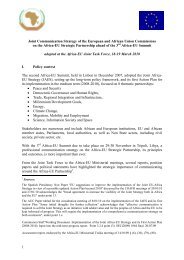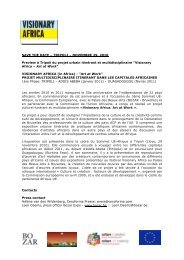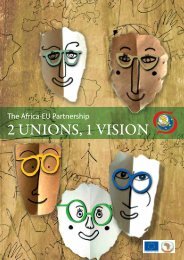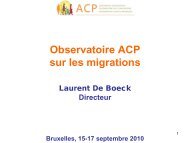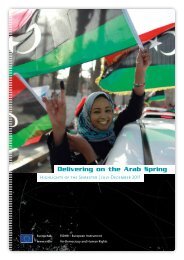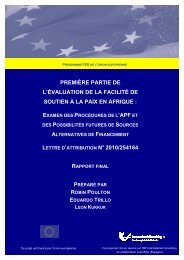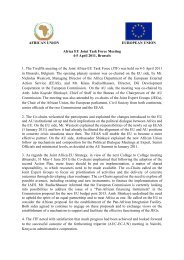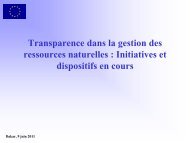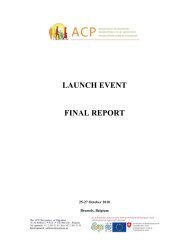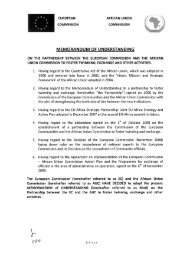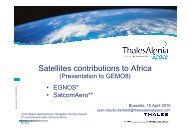part 1 of the african peace facility evaluation - European ...
part 1 of the african peace facility evaluation - European ...
part 1 of the african peace facility evaluation - European ...
Create successful ePaper yourself
Turn your PDF publications into a flip-book with our unique Google optimized e-Paper software.
disbursement <strong>of</strong> funds and identify inefficiencies, overlaps and gaps that can be<br />
streamlined. This will allow APF to position itself more clearly as <strong>the</strong> primary <strong>part</strong>ner <strong>of</strong><br />
APSA. The box below illustrates this point with a case study where both RECs and <strong>the</strong> AU<br />
could have benefitted from closer co-ordination.<br />
Re-establishing a balance between <strong>the</strong> <strong>part</strong>s <strong>of</strong> APSA, making better use <strong>of</strong> resources<br />
allocated to <strong>the</strong> early-warning-early-intervention, mediation and conflict management<br />
functions. In <strong>the</strong> longer term, this may reduce <strong>the</strong> demands <strong>of</strong> funding <strong>of</strong> expensive<br />
conflict prevention and PSO interventions. APSA long-term policies and institution building<br />
have not received adequate prioritisation at <strong>the</strong> political level, perhaps hampered by <strong>the</strong><br />
urgency <strong>of</strong> <strong>the</strong> need to fund PSOs. Key elements <strong>of</strong> APSA are not functioning as<br />
envisaged. Promoting cost-effective conflict management processes will streng<strong>the</strong>n AU<br />
and RECs as institutions contributing effectively to <strong>peace</strong> and security.<br />
NIP and APF. The <strong>evaluation</strong> recommends that <strong>the</strong> ‘slicing’ precedent <strong>of</strong> 1st APF should<br />
be re-introduced. By receiving an allocation from each AU MS representing a ‘slice’ <strong>of</strong><br />
<strong>the</strong>ir NIP, <strong>the</strong> APF will bring greater African ownership to <strong>the</strong> Facility as <strong>the</strong> political will be<br />
generated from both AU and EU MS. This will involve negotiations and require<br />
commitment from all EU Delegations and AU MS. It will also streng<strong>the</strong>n AU member<br />
states’ ‘buy-in’ and link <strong>the</strong> AU <strong>of</strong>ficials in PSOD more closely to <strong>the</strong> political decisionmaking<br />
<strong>of</strong> <strong>the</strong> elected 15-nation PSC. AU MS commitment to APSA and to <strong>the</strong> AU can<br />
only be enhanced. A co-funding arrangement will free financial resources for <strong>the</strong> APF and<br />
ensure that regular and sustainable funds are available. That said, an issue needs to be<br />
considered if this option is pursued: What aid modalities and implementing procedures<br />
should <strong>the</strong> NIPs use to effectively support <strong>the</strong> regional aspects <strong>of</strong> APSA and specific<br />
<strong>peace</strong> and security-initiatives<br />
RIP and REC. APF coordination has been fairly effective with RIPs. Consultations with<br />
<strong>of</strong>ficials in <strong>the</strong> ECCAS, ECOWAS, SADC, IGAD and EAC regions lead <strong>the</strong> <strong>evaluation</strong> to<br />
<strong>the</strong> conclusion that APF should focus on <strong>the</strong> AU and APSA, leaving <strong>the</strong> RECs to be<br />
funded by RIP. RECs currently appear well funded. The absorptive capacity <strong>of</strong> RECs may<br />
impose limitations to absorb all <strong>the</strong> financial resources at <strong>the</strong>ir disposal (including bilateral<br />
arrangements), whereas APF resources are over-stretched by <strong>the</strong> demands <strong>of</strong> PSOs.<br />
Moreover, APSA support should entail direct support to o<strong>the</strong>r actors than just <strong>the</strong> AU as<br />
mentioned elsewhere in <strong>the</strong> <strong>evaluation</strong>.<br />
Lack <strong>of</strong> Synergy between RECs and <strong>the</strong> APF<br />
Under <strong>the</strong> 10 th EDF a Regional Strategy Paper (RSP) was signed between <strong>the</strong> EU and <strong>the</strong> Eastern and<br />
Sou<strong>the</strong>rn African Region - COMESA/IGAD/EAC/Indian Ocean Community(IOC). This is a grouping <strong>of</strong><br />
RECs with many overlapping memberships. The RSP had two main focal areas: P&S and Trade, with a<br />
smaller component for Co-ordination and functional co-operation, making a total <strong>of</strong> €645m.<br />
€80m was allocated to P&S. IGAD took <strong>the</strong> lead in P&S. Responsibility is allocated to a REC based on<br />
regional capacity. Initially €5m <strong>of</strong> <strong>the</strong> P&S funding was allocated in <strong>the</strong> first phase, towards a ‘Regional<br />
Human Security Governance Programme’ led by EAC.<br />
None <strong>of</strong> <strong>the</strong> remaining funds have been used for to date, although IGAD has been preparing a programme<br />
on Maritime Security.<br />
Under <strong>the</strong> 9 th EDF COMESA had a component to deal with war economies. Pressured by outside actors,<br />
including <strong>the</strong> EU during <strong>the</strong> 10 th EDF, COMESA decided to do something on piracy. No research was done<br />
on this. The initiatives came from <strong>the</strong> EU.<br />
Page 46 <strong>of</strong> 49




